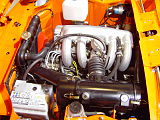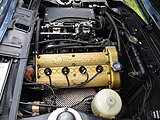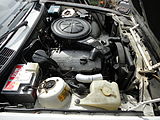BMW M10
|
||||||||||||||||||||||
BMW M10 is the internal name for a series of internal combustion engines ( Otto engines ) from BMW .
These are four-cylinder in - line engines with 1.5 to 2 liters displacement and OHC valve control . The camshaft in the cross-flow cylinder head , driven by a roller chain , actuates two V-shaped hanging valves per cylinder via rocker arms . Another roller chain drives the oil pump. The M10 was first used in the New Class presented by BMW in 1961 and remained in production until 1988. The basic construction principle with 100 mm cylinder spacing and gray cast iron as the engine block material was adopted in the development of the six-cylinder BMW M30 ; the M10 also formed the basis for the BMW S14 .
In its long career, the engine was also used in touring cars , rally vehicles and in formula racing. With the M12 / 13/1 *, the engine in Formula 1 reached its highest level of development in the early 1980s.
Series engines
nomenclature
From 1963, new rules for naming vehicle and engine projects were introduced at BMW; Vehicle projects received an Exx and engine projects an Mxx , with each letter followed by a number starting with 01. This has not yet been applied to the first four-cylinder engines of the New Class , as the original M113 engine was developed in the late 1950s, this was then further developed into the M115 , which debuted in the BMW 1500 in 1961; Only the two-liter engine of the BMW 2000, which had been further developed, was then given the name M05 in 1965 . The numbering did not follow any system, but was purely chronological.
Since this system had reached numbers just below 100 at the end of the 1970s, a new, ordering system was introduced retrospectively from 1980:
| designation | Number of cylinders | Cylinder spacing | construction time | comment |
|---|---|---|---|---|
| M10 | 4 (row) | 100 mm | 1962-1988 | All four-cylinder |
| M20 | 6 (row) | 91 mm | 1976-1992 | "Small" six-cylinder (2.0-2.7 liters) |
| M30 | 6 (row) | 100 mm | 1968-1994 | "Large" six-cylinder (2.5-3.8 liters) |
Different code letters were defined for the individual corporate divisions: M (now also N ) stands for “BMW AG / Personenwagen”, S stands for “Motorsport GmbH”, A stands for “motorcycle” and W for “marine, stationary etc.”. For example, the motorsport and racing engines were prefixed with the letter S, the following number is based on the basic family in the first digit; the S14 is based on the M10 and the S38 on the M30 . This system is still used at BMW today. For better differentiation, the engines from 1963–1980 are often marked with an *.
Engine variants
The engine was designed by Alexander von Falkenhausen , who instead of the 1.3-liter engine that had been commissioned, designed an engine with a displacement of 1.5 liters and was already planning to enlarge it to up to two liters.
A single downdraft carburetor was used to prepare the mixture for the original 1.5-liter engine with 75 or 80 hp . This basic concept was followed by variants with 1.6, 1.8 and 2 liters displacement. With one carburetor, the two-liter engines achieved 100 HP, while the models equipped with two flat - flow twin carburettors developed between 105 and 120 HP. The 2000/2002 tii / 520i models with mechanical Kugelfischer injection produced 130 hp. The 2002 turbo , presented in 1973, even achieved 170 hp with an exhaust gas turbocharger .
In 1981 a 1766 cc variant of the engine with K-Jetronic manifold injection followed for the BMW E28.
At the end of the 1980s, the BMW S14 four-valve engine in the BMW M3 (model series E30) was first expanded to 2.3, then 2.5 liters and the production version was already expanded to over 200 hp. The construction of the S14 is based on a slightly modified M10 engine block and a shortened cylinder head from the six-cylinder BMW M88 * (which was also used in the BMW M1 ). Like this one, it had individual throttle valves, but electronic instead of mechanical injection.
- BMW M10 series and tuning engines
M10 engine in the BMW 1600 GT , 105 PS (1967)
M10 engine from the BMW 2002 tii with Kugelfischer injection
M10 engine of the BMW 2002 turbo with Kugelfischer injection
M10 engine BMW 2002 tii Alpina A4 with Kugelfischer injection and Alpina single throttle system
M10 engine with Schnitzer 16V cylinder head in a BMW 2002
M10 engine of the BMW E30 with Pierburg 2BE carburettor
M10 engine of the BMW E30 with L-Jetronic
Racing engines
While BMW left it with 2 valves per cylinder for the series engines until the 1970s, Kugelfischer injections with individual throttle valves or flat slide valves and four-valve cylinder heads were used during the European Touring Car Championship . In Formula 2 (where the engines based on the M10 were extremely successful) and the German racing championship , 300 hp were already possible. During this time Schnitzer Motorsport also developed a four-valve cylinder head for the BMW M10, all other four-valve engines came from the factory. This was primarily designed for use in touring cars and rally vehicles of the type BMW 02 .
Formula 3
For Formula 3, there was an engine for Formula 3 based on the M10 two-valve engine with the same type designation M70 as the later twelve-cylinder BMW M70 . At that time, the regulations stipulated a displacement of 2 liters, a maximum of 4 cylinders as well as the crankcase and cylinder head of a series engine manufactured at least 5,000 times. For the 1976 season, the engine with flat slide and Kugelfischer injection was specified with 165 hp.
Formula 2

In 1966 the new Formula 2 racing engine BMW M10 * with the four-valve cylinder head invented by Ludwig Apfelbeck was ready. Derived from the series engine of the BMW 2000, the DOHC 16V 2 liter engine had a Kugelfischer injection and a flat slide valve system. The capacity was 1990 cm 3 (bore x stroke: 89 mm × 80 mm), their maximum torque of 236 Nm reached the engine at 8000 min -1 . The maximum power is 191 kW (260 hp) at 8500 min -1 indicated.
Alexander von Falkenhausen used the M10 * for his world record drives with the BMW F1 2000 (chassis Brabham BT7 ) over 500 meters and the quarter mile. The M10 * was also used in the "Monti" Bergspider ( Lola T120).
The theoretical advantages of the Apfelbeck cylinder head design consisted of a very good gas exchange due to the largest possible valve openings and the thermal insensitivity due to the fact that the exhaust valves were not adjacent. The disadvantages of this engine , in addition to an unfavorable ratio of stroke, bore and duct diameter, and the extremely complex valve train, included the need to raise the piston crown due to the large volume of the hemispherical combustion chamber to achieve sufficient compression, which, however, increased the piston weight . In addition, the valve pockets milled into the piston crown resulted in an overall jagged combustion chamber, and the gas exchange advantage was reversed at low engine speeds, as the large valves made the inflow gas velocities into the cylinder too low and there was no longer sufficient fresh gas filling. The engine was therefore not particularly successful in racing - apart from a few acceleration records.
The contemporary Cosworth four-valve engine with the simpler, roof-shaped combustion chamber with valves hanging in parallel and a flat piston crown showed that a corresponding power output was also easier to achieve. In 1968, under the direction of Paul Rosche , the BMW M12 * with diametrically opposed inlet and outlet valves was designed. In accordance with the regulations, it was reduced to 1.6 liters in Formula 2 in the BMW T102 . To further increase performance, this engine was later equipped with three spark plugs per cylinder, and the Lucas injection of the Formula 2 Apfelbeck M10 was replaced by a Kugelfischer injection . The BMW M12 / 2 * , which was used for the first time during the 1970 Formula 2 season , then had the valve layout that is common today with valves hanging in parallel and performing the same function.
In 1973 the very successful four-cylinder four-valve engine with the designation BMW M12 / 6 * emerged from this . After the change in the Formula 2 regulations, the engine now had a displacement of two liters and achieved up to 330 hp and served as the basis for the large four-valve, six-cylinder M49 * racing engines. The two-liter four-valve engines used in the BMW 2002 racing touring and rally cars, however, were from Schnitzer Motorsport . In contrast to these, the factory four-valve BMW M12 / 7 * intake and exhaust tracts were on the 'wrong' side: (exhaust left instead of right, intake manifold right instead of left). The BMW M12 / 7 * Formula 2 engine 1976 reached its maximum torque of 251 Nm at 7500 min -1 and its maximum power of 315 hp at 9500 min -1 .
formula 1

On April 24, 1980, BMW announced that the company would become involved as an engine supplier for Formula 1. BMW engine designer Paul Rosche designed the BMW M12 / 13 * , a four- valve engine reduced to 1.5 liters displacement from a four-cylinder series block , which initially developed around 488 kW (650 hp) by means of a turbocharger and special fuel . In the course of further development, the engine achieved up to 1029 kW (1400 PS). and was thus able to deliver 20 times the performance of the basic model with the same displacement. An electronically enhanced mechanical Kugelfischer injection was used in the engine.
The engine celebrated its premiere in the premier class of motorsport on January 23, 1982 with Nelson Piquet and Riccardo Patrese in a Brabham BMW at the season opener in Kyalami . When the new engine was used for the fifth time on May 9, 1982, Piquet collected his first championship points as fifth in the Belgian GP. The Brazilian won his first victory at the Canadian Grand Prix in Montreal on June 13, 1982 , and his first pole position on August 15, 1982 in Zeltweg.
In the 1983 Formula 1 season , BMW and the British team won the first Formula 1 world championship with a turbo engine. 630 days had passed since the BMW M12 / 13 * was first used. After BMW's withdrawal in 1986, the engines were used in Formula 1 under the name Megatron until the turbo engines were banned in 1989.
Individual evidence
- ↑ Information on the M10 cylinder spacing from the BMW 02 Club eV , accessed February 21, 2018
- ↑ M10 at BMW 02 Club eV from 2018, accessed February 14, 2018
- ^ Karlheinz Lange: History of the engine - engine of history (BMW dimensions 1 + 2) . Ed .: BMW Mobile Tradition. 1st edition. tape 2 (1945-2000) , 1999, ISBN 3-932169-04-2 , Chapter 9: Talking number system from 1980, p. 176-179 .
- ↑ BMW 518i (E28) available at bmw-grouparchiv.de, March 19, 2018.
- ↑ . https://bmw-grouparchiv.de/research/detail/index.xhtml?id=2483208 , June 2, 2020, accessed on June 2, 2020 .
- ^ Rainer Roßbach: BMW Formula Racing Cars: New Entry in the Sixties. prova magazine, November 15, 2004, accessed November 25, 2012 .
- ↑ Combustion chamber and piston shape in the four-valve engine. (No longer available online.) Archived from the original on November 12, 2013 ; Retrieved November 25, 2012 .
- ↑ Guntram Jordan: People: Paul Rosche - Der Meistermacher . In: Oldtimer Market . No. 1 , January 2006, ISSN 0939-9704 , p. 18-21 .
- ^ A b Karl-Heinz Lohr: Four-valve technology. 02-Club Niederbayern, accessed on November 25, 2012 .
- ↑ a b c Formula 1 history: BMW in Formula 1. motorsport-magazin.com, July 29, 2009, accessed on December 5, 2012 .
- ↑ First victory in the premier class. bmw-motorsport.com, archived from the original on April 10, 2009 ; Retrieved November 25, 2012 .
- ^ Engines: Megatron. F1 News - Grandprix.com, accessed February 5, 2011 .
literature
- Ludwig Apfelbeck : Ways to high-performance four-stroke engines: A manual for fans and tuners of four-stroke engines . Motorbuch Verlag, Stuttgart 2002, ISBN 3-87943-578-2 .
- Ludwig Apfelbeck , Hermann Weichsler: Valve controls for high-performance engines . 1st edition. Motorbuch Verlag, Stuttgart 1991, ISBN 3-613-01272-3 .
- Karl H. Hufstadt: BMW Portraits. Paul Rosche: A brilliant engine designer. Stories about history . Egmont VGS, Cologne 2003, ISBN 3-8025-1520-X .
- Helmut Hütten: Fast engines - dissected and coiffed . 10th edition. Motorbuch Verlag, Stuttgart 1994, ISBN 3-87943-974-5 .
- Stefan Knittel: BMW Profile, Volume 6: Formula racing 1966-2000: A documentation . 1st edition. Heel, Königswinter 2000, ISBN 3-932169-07-7 .
- Stefan Knittel: BMW Profile, Volume 8: Touring and Sports Cars . 1st edition. Egmont VGS, Cologne 2007, ISBN 3-8025-1622-2 .
- Karlheinz Lange: History of the engine - engine of history (BMW dimensions 1 + 2) . Ed .: BMW Mobile Tradition. 1st edition. 1999, ISBN 3-932169-04-2 .
- Horst Mönnich: BMW - A German story . Piper, 2004, ISBN 3-492-04618-5 .
- Werner Oswald, Eberhard Kittler: All BMW automobiles since 1928 . 1st edition. Motorbuch Verlag, Stuttgart 2000, ISBN 3-613-02053-X .
Web links
- Karl-Heinz Lohr: The engine. 02-Club Niederbayern, accessed on November 25, 2012 .
- M10 overview. BMW 02-Club, accessed on April 23, 2018 .
- Remi Humbert: BMW 12 / 13-1. Gurneyflap, accessed November 25, 2012 .
| Timeline of BMW gasoline engines for passenger cars since 1961 | ||||||||||||||||||||||||||||||||||||||||||||||||||||||||||||
|---|---|---|---|---|---|---|---|---|---|---|---|---|---|---|---|---|---|---|---|---|---|---|---|---|---|---|---|---|---|---|---|---|---|---|---|---|---|---|---|---|---|---|---|---|---|---|---|---|---|---|---|---|---|---|---|---|---|---|---|---|
| Number of cylinders | Conception | 1960s | 1970s | 1980s | 1990s | 2000s | 2010s | |||||||||||||||||||||||||||||||||||||||||||||||||||||
| 0 | 1 | 2 | 3 | 4th | 5 | 6th | 7th | 8th | 9 | 0 | 1 | 2 | 3 | 4th | 5 | 6th | 7th | 8th | 9 | 0 | 1 | 2 | 3 | 4th | 5 | 6th | 7th | 8th | 9 | 0 | 1 | 2 | 3 | 4th | 5 | 6th | 7th | 8th | 9 | 0 | 1 | 2 | 3 | 4th | 5 | 6th | 7th | 8th | 9 | 0 | 1 | 2 | 3 | 4th | 5 | 6th | 7th | 8th | ||
| 3 | 1.5 l | B38 | ||||||||||||||||||||||||||||||||||||||||||||||||||||||||||
| 4th | (1.5–2.0 l) | M10 | ||||||||||||||||||||||||||||||||||||||||||||||||||||||||||
| M40 | ||||||||||||||||||||||||||||||||||||||||||||||||||||||||||||
| M42 | ||||||||||||||||||||||||||||||||||||||||||||||||||||||||||||
| M43 | ||||||||||||||||||||||||||||||||||||||||||||||||||||||||||||
| M44 | ||||||||||||||||||||||||||||||||||||||||||||||||||||||||||||
| N40 | ||||||||||||||||||||||||||||||||||||||||||||||||||||||||||||
| N42 | ||||||||||||||||||||||||||||||||||||||||||||||||||||||||||||
| N45 | ||||||||||||||||||||||||||||||||||||||||||||||||||||||||||||
| N46 | ||||||||||||||||||||||||||||||||||||||||||||||||||||||||||||
| N43 | ||||||||||||||||||||||||||||||||||||||||||||||||||||||||||||
| N13 | ||||||||||||||||||||||||||||||||||||||||||||||||||||||||||||
| N20 | ||||||||||||||||||||||||||||||||||||||||||||||||||||||||||||
| B48 | ||||||||||||||||||||||||||||||||||||||||||||||||||||||||||||
| High performance motor | S14 | |||||||||||||||||||||||||||||||||||||||||||||||||||||||||||
| 6th | Small six-cylinder (2.0-3.0 l) | M20 | ||||||||||||||||||||||||||||||||||||||||||||||||||||||||||
| M50 | ||||||||||||||||||||||||||||||||||||||||||||||||||||||||||||
| M52 | ||||||||||||||||||||||||||||||||||||||||||||||||||||||||||||
| M54 | ||||||||||||||||||||||||||||||||||||||||||||||||||||||||||||
| Large six-cylinder (2.5-3.5 l) | M30 | |||||||||||||||||||||||||||||||||||||||||||||||||||||||||||
| N52 | ||||||||||||||||||||||||||||||||||||||||||||||||||||||||||||
| N53 | ||||||||||||||||||||||||||||||||||||||||||||||||||||||||||||
| N54 | ||||||||||||||||||||||||||||||||||||||||||||||||||||||||||||
| N55 | ||||||||||||||||||||||||||||||||||||||||||||||||||||||||||||
| B58 | ||||||||||||||||||||||||||||||||||||||||||||||||||||||||||||
| High performance motor | M88 | |||||||||||||||||||||||||||||||||||||||||||||||||||||||||||
| S38 | ||||||||||||||||||||||||||||||||||||||||||||||||||||||||||||
| S50 | ||||||||||||||||||||||||||||||||||||||||||||||||||||||||||||
| S52 | ||||||||||||||||||||||||||||||||||||||||||||||||||||||||||||
| S54 | ||||||||||||||||||||||||||||||||||||||||||||||||||||||||||||
| S55 | ||||||||||||||||||||||||||||||||||||||||||||||||||||||||||||
| 8th | 3.0-4.4 l | M60 | ||||||||||||||||||||||||||||||||||||||||||||||||||||||||||
| M62 | ||||||||||||||||||||||||||||||||||||||||||||||||||||||||||||
| N62 | ||||||||||||||||||||||||||||||||||||||||||||||||||||||||||||
| N63 | ||||||||||||||||||||||||||||||||||||||||||||||||||||||||||||
| High performance motor | S62 | |||||||||||||||||||||||||||||||||||||||||||||||||||||||||||
| S63 | ||||||||||||||||||||||||||||||||||||||||||||||||||||||||||||
| S65 | ||||||||||||||||||||||||||||||||||||||||||||||||||||||||||||
| 10 | High performance motor | S85 | ||||||||||||||||||||||||||||||||||||||||||||||||||||||||||
| 12 | 5.0-6.6 l | M70 | ||||||||||||||||||||||||||||||||||||||||||||||||||||||||||
| M73 | ||||||||||||||||||||||||||||||||||||||||||||||||||||||||||||
| N73 | ||||||||||||||||||||||||||||||||||||||||||||||||||||||||||||
| N74 | ||||||||||||||||||||||||||||||||||||||||||||||||||||||||||||
| High performance motor | S70 | |||||||||||||||||||||||||||||||||||||||||||||||||||||||||||
| Number of cylinders | Conception | 0 | 1 | 2 | 3 | 4th | 5 | 6th | 7th | 8th | 9 | 0 | 1 | 2 | 3 | 4th | 5 | 6th | 7th | 8th | 9 | 0 | 1 | 2 | 3 | 4th | 5 | 6th | 7th | 8th | 9 | 0 | 1 | 2 | 3 | 4th | 5 | 6th | 7th | 8th | 9 | 0 | 1 | 2 | 3 | 4th | 5 | 6th | 7th | 8th | 9 | 0 | 1 | 2 | 3 | 4th | 5 | 6th | 7th | 8th |
| 1960s | 1970s | 1980s | 1990s | 2000s | 2010s | |||||||||||||||||||||||||||||||||||||||||||||||||||||||









